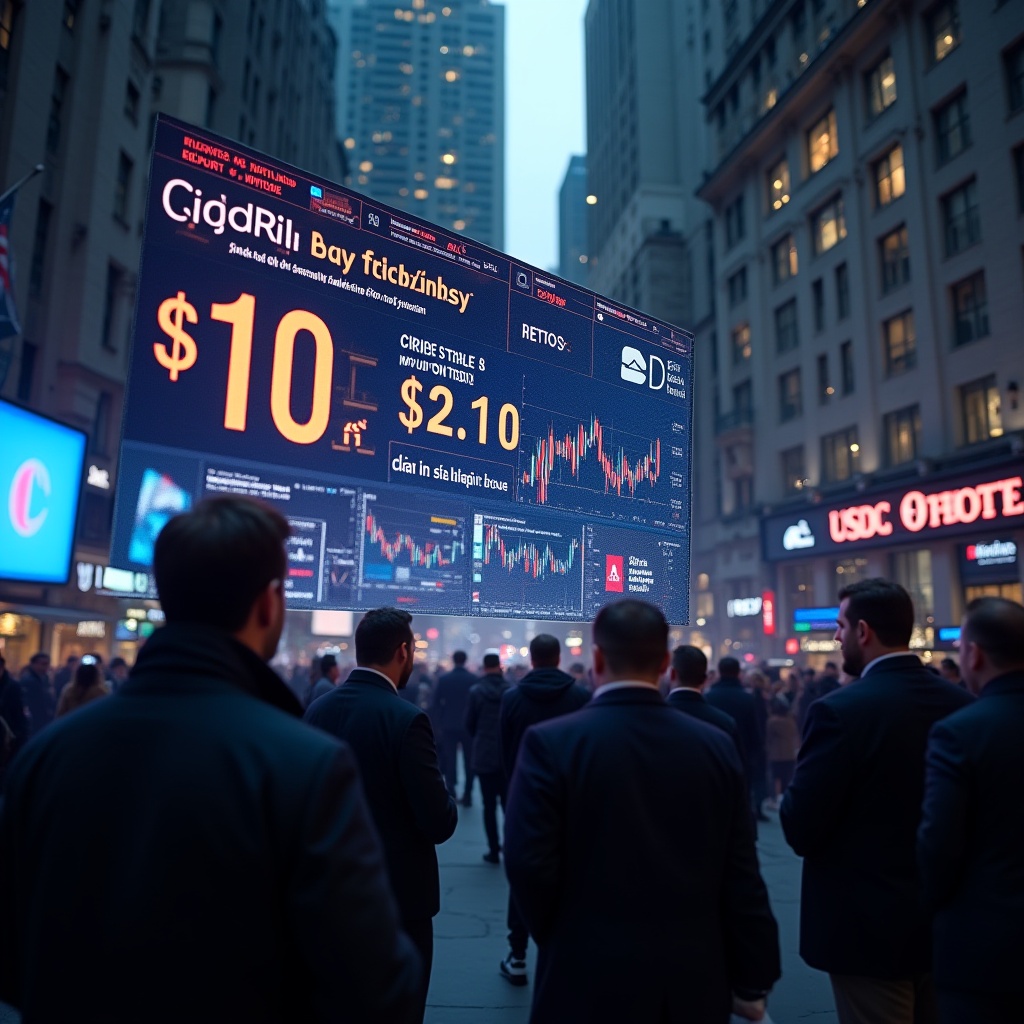Circle’s IPO has propelled the company to a $16 billion valuation, signaling robust investor confidence in stablecoins and digital assets. The debut has revitalized interest in the stablecoin sector, with USDC’s prominence underscored.
Circle’s IPO: A Market Milestone
IPO Overview
Circle Internet Group Inc., the issuer of the USDC stablecoin, made its debut on the New York Stock Exchange (NYSE) under the ticker symbol CRCL. The company priced its initial public offering (IPO) at $31 per share, raising approximately $1.1 billion by offering 34 million shares. This pricing was above the initially expected range of $27–$28 per share, indicating strong investor demand.
The stock opened at $69 per share, more than doubling the IPO price, and closed at $83.23, marking a 168% increase on its first day of trading. The following day, shares briefly touched $103.75, valuing the company at over $18 billion.
Institutional Interest
The IPO attracted significant interest from major institutional investors. Notably, BlackRock, the world’s largest asset manager, acquired approximately 10% of the shares offered in the IPO. Additionally, ARK Investment Management, led by Cathie Wood, purchased 4.48 million shares, totaling about $150 million.
These investments underscore the growing institutional confidence in Circle and the broader stablecoin market. BlackRock’s involvement is particularly noteworthy, as it manages the reserves backing USDC, highlighting a deepening integration between traditional finance and digital assets.
USDC: The Backbone of Circle’s Valuation
USDC’s Market Position
As of June 2025, Circle’s USD Coin (USDC) boasts a circulating supply exceeding $61 billion, establishing it as the second-largest stablecoin by market capitalization, trailing only Tether’s USDT. Since its inception in 2018, USDC has facilitated over $25 trillion in on-chain transactions, underscoring its pivotal role in the cryptocurrency ecosystem.
The rapid adoption of USDC is evident, with its circulation growing by more than 78% year-over-year, outpacing other major stablecoins. This growth is attributed to its widespread integration across various blockchain networks and its adoption by over 500 million end-user wallets, enabling seamless transactions and fostering trust among users and institutions alike.
Strategic Developments
Circle’s proactive engagement with regulatory bodies has positioned USDC as a compliant and transparent stablecoin. The company’s commitment to regulatory clarity is reflected in its regular reserve attestations by reputable third-party auditors, ensuring that each USDC is fully backed by highly liquid cash and cash-equivalent assets.
Furthermore, Circle’s strategic partnerships have expanded USDC’s utility beyond traditional cryptocurrency exchanges. Collaborations with financial institutions and fintech companies have facilitated the integration of USDC into real-world applications, such as cross-border payments and decentralized finance (DeFi) platforms. For instance, the launch of the Circle Payments Network (CPN) enables businesses to leverage USDC for efficient and cost-effective international transactions.
Future Outlook
Looking ahead, Circle aims to further enhance USDC’s capabilities by expanding its presence across additional blockchain networks and exploring new use cases. The upcoming release of CCTP V2 (Cross-Chain Transfer Protocol) is expected to improve the speed and efficiency of USDC transfers across supported chains, fostering greater interoperability within the blockchain ecosystem.
Additionally, Circle’s focus on developing enterprise-grade solutions, such as programmable payments and on-chain treasury services, positions USDC as a foundational component of the evolving digital financial infrastructure. These initiatives aim to cater to the growing demand for secure and scalable financial solutions in the digital age.
Financial Performance and Valuation Metrics
Revenue Streams
Circle’s primary revenue source stems from the interest earned on the reserves backing its USD Coin (USDC). In the first quarter of 2025, the company reported revenues of $578.6 million, with approximately $557 million (or about 96%) derived from interest on U.S. Treasury bills held as reserves. This marks a 55% increase from the same period in the previous year, highlighting the company’s strong performance in a rising interest rate environment.
Additionally, Circle generates revenue through transaction fees, API services, and other financial products. However, these non-reserve income streams currently account for a smaller portion of total revenue, emphasizing the company’s reliance on interest income.
Profitability Analysis
Despite robust revenue growth, Circle faces challenges in achieving high profitability. In Q1 2025, the company reported a net income of $64.8 million, translating to a profit margin of approximately 11.2%. This margin is relatively modest, reflecting the significant costs associated with its operations.
A major factor impacting profitability is Circle’s agreement with Coinbase, which entitles Coinbase to a substantial portion of the revenue generated from USDC transactions. This partnership, while beneficial for distribution, imposes a significant cost on Circle’s bottom line.
Valuation Metrics
Circle’s valuation has experienced significant fluctuations, influenced by market conditions and investor sentiment. At the time of its IPO, the company was valued at approximately $18.4 billion, based on the share price of $83.23. However, subsequent market activity saw the stock price rise to $103.75, increasing the valuation to over $22 billion.
This volatility underscores the sensitivity of Circle’s valuation to external factors, including interest rates, regulatory developments, and market perceptions of the cryptocurrency sector.
Market Position and Competitive Landscape
Circle operates in a competitive environment, with major players like Tether (USDT) and emerging stablecoins vying for market share. As of early 2025, USDC’s circulation surpassed $60 billion, positioning it as the second-largest stablecoin by market capitalization.
The company’s market position is further bolstered by its regulatory compliance, including obtaining a BitLicense from the New York Department of Financial Services and its proactive engagement with U.S. regulators. These factors enhance investor confidence and differentiate Circle from competitors operating in less regulated environments.
Regulatory Landscape and Institutional Adoption
Regulatory Developments
Circle’s commitment to regulatory compliance has been instrumental in establishing USDC as a trusted stablecoin in the global financial ecosystem. The company’s proactive approach includes obtaining licenses and approvals from various regulatory bodies, ensuring that USDC operates within established legal frameworks.
**BitLicense and New York State Approval**
In 2015, Circle became the first company to receive a BitLicense from the New York State Department of Financial Services (NYDFS), granting it the authority to conduct virtual currency business activities in New York State. This milestone underscored Circle’s commitment to adhering to stringent regulatory standards and positioned USDC as a compliant digital asset in the U.S. market.
**Global Regulatory Engagement**
Beyond the United States, Circle has actively engaged with regulators worldwide to ensure that USDC aligns with international financial regulations. The company has sought approvals and licenses in various jurisdictions, demonstrating its dedication to operating within the legal frameworks of multiple countries.
**On-Chain Compliance Initiatives**
To further enhance transparency and accountability, Circle has developed on-chain compliance solutions. These initiatives aim to provide real-time visibility into USDC transactions, facilitating compliance with anti-money laundering (AML) and know-your-customer (KYC) regulations. By leveraging blockchain technology, Circle seeks to create a more transparent and accountable digital asset ecosystem.
Institutional Adoption
The regulatory clarity surrounding USDC has played a pivotal role in driving its adoption among institutional investors and enterprises. Circle’s strategic partnerships and compliance efforts have positioned USDC as a preferred stablecoin for various financial applications.
**Strategic Partnerships**
Circle has formed alliances with major financial institutions and platforms to expand the use of USDC. For instance, the partnership with Binance aims to integrate USDC across Binance’s global platform, enabling users to utilize the stablecoin for trading, savings, and payments. Additionally, Binance has adopted USDC as a vital dollar stablecoin for its corporate treasury, signaling confidence in USDC’s stability and compliance.
**Enterprise Solutions**
Circle offers enterprise-grade solutions that facilitate the integration of USDC into various business operations. These solutions include programmable wallets, cross-border payment infrastructure, and tokenized asset platforms, enabling businesses to leverage USDC for efficient and compliant financial transactions.
**Global Expansion**
The adoption of USDC extends beyond the United States, with Circle’s initiatives promoting the stablecoin’s use in international markets. Through partnerships with global financial institutions and adherence to international regulatory standards, Circle aims to position USDC as a leading stablecoin in the global financial ecosystem.
Market Dynamics and Competitive Landscape
Competitive Analysis
As of June 2025, Circle’s USD Coin (USDC) holds a market capitalization of approximately $61 billion, positioning it as the second-largest stablecoin globally, following Tether’s USDT, which leads with a market cap of around $153.8 billion.
Despite trailing USDT in total market cap, USDC has experienced significant growth, capturing nearly 29% of the stablecoin market. This growth is attributed to Circle’s commitment to regulatory compliance, transparency, and strategic partnerships that have expanded USDC’s use cases across various blockchain networks and financial applications.
The competitive landscape for stablecoins is evolving, with new entrants and traditional financial institutions exploring their own digital currencies. Circle’s emphasis on regulatory clarity and institutional adoption positions USDC to maintain and potentially grow its market share in this dynamic environment.
Market Trends
The stablecoin sector is experiencing notable growth, driven by several key factors:
- Institutional Adoption: Increasingly, financial institutions are integrating stablecoins into their operations for purposes such as cross-border payments, treasury management, and digital asset trading.
- Regulatory Clarity: Legislative efforts, particularly in the United States, aim to provide clear frameworks for stablecoin operations, enhancing trust and stability in the market.
- Technological Advancements: Innovations in blockchain technology are improving the scalability and efficiency of stablecoin transactions, making them more appealing for various applications.
Circle’s proactive engagement with regulators and its focus on building a robust infrastructure position USDC to capitalize on these trends. The company’s efforts to expand its presence across multiple blockchain networks and develop enterprise-grade solutions further solidify its competitive edge.
Strategic Positioning
Circle’s strategy centers on becoming the foundational layer for digital finance. By offering programmable payment solutions, on-chain treasury services, and integrating USDC into various blockchain ecosystems, Circle aims to provide comprehensive financial infrastructure. This approach not only enhances the utility of USDC but also fosters deeper integration into the global financial system.
The company’s successful IPO and subsequent market performance reflect investor confidence in this vision. As the digital asset landscape continues to evolve, Circle’s commitment to innovation, compliance, and infrastructure development positions it as a leader in the stablecoin sector.
Future Outlook and Investment Considerations
Growth Opportunities
Circle’s recent IPO marks a significant milestone in its evolution from a stablecoin issuer to a comprehensive digital financial infrastructure provider. The company’s strategic initiatives position it to capitalize on the growing demand for regulated digital assets and blockchain-based financial services.
Expansion of USDC’s Utility
Circle’s USD Coin (USDC) has established itself as a leading stablecoin, with a circulating supply exceeding $61 billion. The company’s efforts to expand USDC’s utility across various blockchain networks and financial applications are pivotal to its growth strategy. The launch of the Circle Payments Network (CPN) facilitates cross-border payments, treasury management, and supplier payments, with early adoption in regions like Latin America. This expansion enhances USDC’s role in the global financial ecosystem.
Enterprise Solutions and Tokenization
Circle offers enterprise-grade solutions, including programmable wallets, smart contract services, and tokenization platforms, enabling businesses to leverage USDC for efficient and compliant financial transactions. These solutions cater to the growing demand for secure and scalable financial infrastructure in the digital age.
Global Regulatory Engagement
Circle’s proactive engagement with regulators worldwide ensures that USDC aligns with international financial regulations. The company’s commitment to regulatory clarity enhances its credibility and operational stability, fostering trust among institutional investors and enterprises.
Risks and Challenges
Interest Rate Sensitivity
Circle’s revenue model is heavily reliant on the interest earned from reserves backing USDC. Fluctuations in interest rates can significantly impact profitability. While higher rates have historically benefited Circle, a declining interest rate environment could reduce income from these reserves. Projections indicate that every 25 basis point cut by the Federal Reserve could reduce Circle’s annual net income by approximately $30 million.
Regulatory Uncertainty
The evolving regulatory landscape for stablecoins presents both opportunities and challenges. While regulatory clarity can enhance legitimacy, stringent regulations could impose compliance costs and operational constraints. Circle’s proactive engagement with regulators aims to navigate these challenges, but the outcome remains uncertain.
Competitive Pressures
The stablecoin market is becoming increasingly competitive, with new entrants and traditional financial institutions exploring their own digital currencies. Circle’s ability to maintain its market position will depend on its capacity to innovate, expand its user base, and differentiate itself from competitors.
Investment Considerations
Valuation and Market Sentiment
Circle’s IPO was met with significant investor enthusiasm, leading to a substantial increase in stock price. As of June 10, 2025, Circle’s stock (CRCL) is trading at $105.42, reflecting a market capitalization of approximately $18.4 billion. This valuation positions Circle as a leading entity in the fintech space, but investors should consider the company’s growth prospects and associated risks when evaluating its stock.
Long-Term Potential
Circle’s strategic initiatives, including the expansion of USDC’s utility and the development of digital financial infrastructure, suggest a focus on long-term growth. Investors with a long-term horizon may find Circle’s vision and market positioning appealing, provided they are comfortable with the inherent risks of the digital asset sector.
Final Thought
Circle’s evolution from a stablecoin issuer to a comprehensive digital financial infrastructure provider underscores its commitment to innovation and growth. While the company faces challenges related to interest rate sensitivity, regulatory uncertainty, and market competition, its strategic initiatives position it to capitalize on the expanding digital asset ecosystem. Investors should weigh these factors carefully when considering Circle as a potential investment opportunity.





